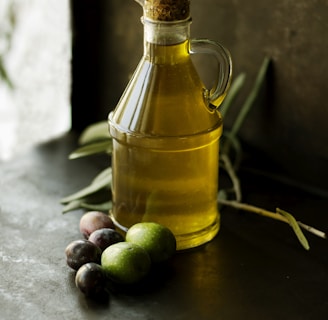Top Benefits of Olive Oil in Cooking | Types of Olive Oils & Best Uses
Discover the top health benefits of olive oil, plus a guide to the different types of olive oils and how to use them in cooking for maximum flavor and nutrition.
COOKING OILS
Jennifer
9/13/20252 min read


Some links are affiliate links, which may earn a commission at no extra cost.
Top Benefits of Olive Oil in Cooking
Olive oil, often called liquid gold, is one of the healthiest and most versatile oils you can use in your kitchen. Packed with nutrients and antioxidants, it not only enhances the flavor of your meals but also provides powerful health benefits.
In this guide, we’ll cover the top health benefits of olive oil, explain the different types of olive oils, and help you decide which olive oil is best for cooking.
Health Benefits of Olive Oil in Cooking
1. Supports Heart Health
Olive oil is rich in monounsaturated fats, especially oleic acid, which helps lower LDL (“bad”) cholesterol and raise HDL (“good”) cholesterol. Regular use may reduce the risk of heart disease and high blood pressure.
2. Rich in Antioxidants
High-quality olive oils—especially extra virgin—are packed with polyphenols and vitamin E, which protect your cells from oxidative stress and promote healthy aging.
3. Reduces Inflammation
Olive oil contains compounds with anti-inflammatory effects, which may help ease arthritis symptoms and lower the risk of chronic diseases.
4. Boosts Brain Health
Studies suggest olive oil can support memory, reduce cognitive decline, and protect against neurodegenerative conditions.
5. Improves Nutrient Absorption
Fat-soluble vitamins (A, D, E, K) are absorbed better when eaten with healthy fats like olive oil. Drizzling olive oil over vegetables makes them more nutritious.
6. Enhances Flavor Naturally
From fruity to peppery, olive oil adds depth and complexity to recipes—whether you’re sautéing, baking, or finishing a dish with a drizzle.
Different Types of Olive Oil and Their Uses
1. Extra Virgin Olive Oil (EVOO)
Best for: salad dressings, drizzling, dips, and low-to-medium heat cooking
Flavor: fruity, bold, sometimes peppery
La Tourangelle offers several rich flavored oils, including Extra Virgin Olive Oil, as well as Avocado
2. Virgin Olive Oil
Best for: roasting, marinades, sauces, everyday stovetop cooking
Flavor: milder than extra virgin
3. Pure or Regular Olive Oil
Best for: frying, stir-fries, sautéing, high-heat cooking
Flavor: light and subtle
4. Light Olive Oil
Best for: baking, grilling, roasting at high heat
Flavor: very mild, almost neutral
5. Infused Olive Oils
Best for: pizzas, pasta, bread dipping, quick flavor boosts
Flavor: varies (garlic, rosemary, chili, lemon, etc.)
Basso 1904 Infused Extra Virgin Olive Oil Gift Box available on Amazon
Which Olive Oil Is Best for Cooking?
Extra virgin olive oil → best for dressings, dips, and finishing dishes.
Regular or light olive oil → best for frying, roasting, and baking.
Infused olive oils → best for adding instant gourmet flavor.
Cooking with olive oil is one of the simplest ways to boost both flavor and nutrition in your meals. With its heart-protective properties, antioxidant power, and culinary versatility, olive oil deserves a permanent place in your kitchen.
By learning the different types of olive oils and their best uses, you can make the most of this healthy and delicious staple every day.
Tip: We always buy our olive oil in dark glass jars or cans. We try to avoid plastic bottles and definitely clear bottles.
As always, content provided is for informational purposes only and should not be considered a substitute for professional guidance. For more information, please visit our Terms and Conditions page.


Policies
find us on social media
hello@pureblissholdings.com
© 2025. All rights reserved.
CONTACT US
subscribe to our upcoming newsletter